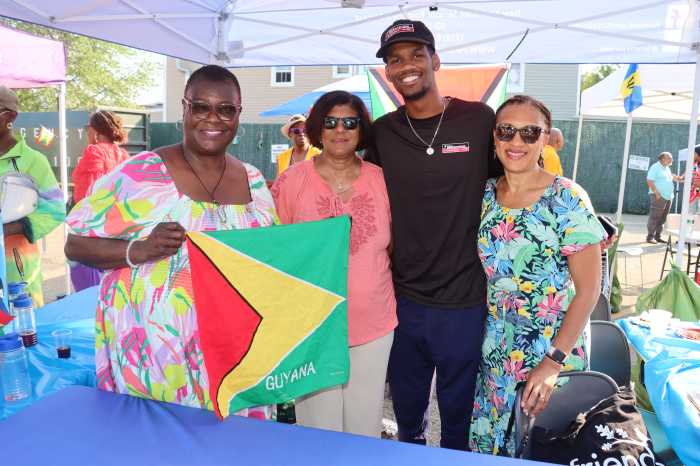The message to the Caribbean people is to make our own government. And so, our own economies. There are enough riches on the ground, in the communities, to do so.
The communities of the Caribbean are paved with gold. Local roads, local, local commons, local corporations, local parlours, local churches, local schools, local police station, local farms, local health centers, pickups, vans, motor cars and more recently, the Internet, connecting the local with the global, the planet. Built by the people, ever since they shattered the ashen urn of Empire, plantation, which held them, and walked free.
One week ago, I went to a pigeon peas festival in Covigne Road, Diego Martin. At the Y of the road, the street was lined on one side with tents. Each tent carried a product, each made from pigeon peas. Pigeon peas wine, pigeon peas dip/relish, pigeon peas liqueur, pigeon peas pastelles, pigeon peas and rice, pigeon peas lasagne, pigeon peas soup, pigeon peas bread, pigeon peas sweetbread, pigeon peas punch, pigeon peas pizza, pigeon peas ponche crème, pigeon peas roti, and curried pigeon peas and eddoes which my mother carried.
All this was the product of the local: the local leaders, local expertise (the local farmer, Mr. Francois), local police, local corporation, local entrepreneurs/vendors/traders (mostly women), local church, local transport, local road, local school, local commons, that is the steep hills above Covigne Road, where he pigeon peas crop was reaped. Local production.
Nobody owns the hills above Covigne hills. It is shared property: commons. The goal is to grow the entire hills of Upper Covigne Road, way up to the mountain peak, with pigeon peas. A large tract of pigeon peas flourishing uphill. I was told that Covigne produces a special brand of pigeon peas. Large, full, bright, like pearls. The soil here, the sun, the uphill relief is just right for this species of peas. And this peas have grown here historically. And that the only chemical additive was pesticides, to keep fungus in the soil from spoiling the pod, the grains.
This is not the only pigeon peas economy I know. In Claxton Bay, where I grew up, there is a thriving pigeon peas economy. Seven bags were sold in twenty minutes at the stall next to the fishing port that morning, mopped up like hot hops. Pigeon peas gone ballistic! On the hills above Pranz Gardens, where citizens revolted and brought an end to the Essar Steel Complex, a 100 percent foreign deal, in the locality, pigeon peas abound. The soil is good for another species of pigeon peas. Weather, soil type: pigeon peas could grow on dry ground. In each yard, families plant a pigeon peas or two.
These are the economies of the future. Local expertise, local communities, local expertise, the local leaders, traders, vendors, producing and trading goods, developed from local commons, shared property. Hundreds of such economies. All along the West and East coast, the hills, the plains of Caroni and Naparima. Local products, traded locally, using local expertise. And through the Caribbean. Hardly a cent in U.S., Forex, fiat currency involved.
Within the next 20 years, our central government’s capacity will wither away: exorbitant public debt; ungovernable public sector wage bills; “development” error; global recession, leading to fiscal shortfalls; and extreme climate events. When the metaphorical tsunami hits, it is not the prime minister, the Cabinet and Parliament who will to save us; it is the local: land, leadership, corporation. Ordinary citizens, whilst giving to Caesar with is Caesar’s, now have no choice but to make our own governments.
It is local police who will have to protect us: burn down the marijuana to plant pigeon peas. Local churches and temples, mosques: build spaces of sanctuary to serve food, a meal a day, books, clothes. Local corporations: with their fund of tractors, backhoes, storehouses for fertilizers. Local schools: with space and knowledge of common spaces, revolutionized curricula. Local entrepreneurs and traders: building economies, milk, cocoa, coconut, fruit crop, horticulture, communications, selling products inter and intra-regionally. Local commons: seas, abandoned fields, lagoons, estates. Local stadia gyms, health clinics, libraries: mutual, permanent training and education.
And local presidents and prime ministers, hoods of good not guns, to take charge, lead. Local women, taking off their make-work overalls and replacing them with lab-coats and managers’ frocks. Little economies, sprinkled through the Caribbean states, supported by local buyers, consumers, traders create big economies. We are the government.
The citizens of Covigne Road showed off a template for Caribbean development. Each district, community determines and build its own production capacity for its own product. All of this amounts to a national, regional, production plan. A large conglomeration of tradable items. This will bring exponential growth and the famous “spin-offs” for the century ahead. It overcome the famous “trickle-down” economy, where money is anti-gravitational, and create a lateral one.




















